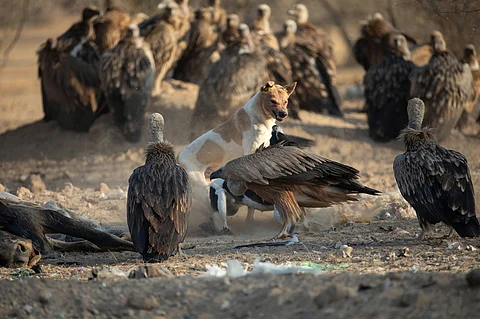

This is the fourth in a 6-part series. Read the first, second, third, fifth and sixth parts
On August 11, a 2-judge bench of Justice J B Pardiwala and Justice R Mahadevan directed that stray dogs be removed from the streets of Delhi and the National Capital Region as early as possible.
The bench had taken suo motu cognisance of a news report in the Times of India’s Delhi edition on July 28. It noted that the news item contained “very disturbing and alarming” figures and facts.
The Chief Justice of India B R Gavai later shifted the case from a two-judge Supreme Court bench to a three-judge one. The new bench, headed by Justice Vikram Nath and comprising Justices Sandeep Mehta and N V Anjaria, reserved its order on an interim plea seeking a stay on the earlier directive on August 14.
On August 22, 2025, this bench stayed the earlier order directing the removal of free-ranging dogs from the Delhi-National Capital Region to shelters, while ruling that feeding them in public spaces is illegal.
Down To Earth (DTE) wanted to probe the issue further. In nature, dogs and vultures often compete for carcasses. We wanted to understand the reason behind why dogs have become a menace for humans and non-human animals alike. Could the decline of the vulture in the 1990s have contributed to the dog’s rise?
DTE spoke to a number of experts on the matter. Here, we talk to Chetan Misher, a wildlife ecologist at Wildlife Conservation Trust based out of Rajasthan.
Misher, who is conducting an ongoing study, has found that free-ranging dogs significantly disrupt vulture scavenging behaviour at carcass dump sites, particularly affecting migratory species like Eurasian and Himalayan griffon vultures.
The study shows that as carcass availability increases, so does the population of dogs at these sites—highlighting a cascading consequence of the earlier vulture population collapse in India. With fewer vultures consuming livestock carcasses, more food is available for opportunistic scavengers like dogs, supporting their population growth around dump sites.
Misher explained that dogs impact vultures primarily through direct interference—by harassing or chasing them, and thereby reducing the time vultures spend feeding on carcasses. Even when vultures arrive at a carcass in sufficient numbers to monopolise it, dog interference can reduce their feeding time by as much as 30 per cent.
The presence of dogs delays the arrival of vultures, shortens their feeding windows, and lowers the proportion of individuals able to feed. This is most evident at large, long-standing supplementary feeding sites like Jorbeer, where food availability is predictable but access is compromised due to dog dominance.
The study also revealed that these concentrated feeding sites may inadvertently create ecological traps—attracting large numbers of vultures to predictable food sources but reducing their efficiency and natural foraging across the landscape. In contrast, carcasses placed in less predictable, dispersed locations were either consumed very slowly or not accessed by vultures at all, and instead used by dogs and wild pigs.
The researcher said this disruption in scavenging dynamics does not only impact migratory vultures. It also poses a serious threat to the region’s few remaining resident species like the Indian vulture (Gyps indicus) and white-rumped vulture (Gyps bengalensis), both critically endangered and already present in low numbers.
The long-billed vulture, or Gyps indicus, is classified as Critically Endangered on the IUCN Red List since 2002.
These resident vultures are smaller in size and less dominant in feeding hierarchies compared to griffons and are especially vulnerable to being outcompeted or excluded entirely in situations where dogs are abundant and aggressive, Misher said.
His study notes the near-absence of resident Gyps species at experimental carcasses, suggesting that dog interference may be preventing their return to even historically important feeding grounds.
The findings highlight that accessibility, not just availability, of carcasses is now the main challenge for vulture conservation in the region. Unless the issue of dog interference is addressed, both migratory and resident vultures will continue to struggle, with further consequences for carcass removal, disease regulation, and the broader scavenger guild.
Misher advises a number of measures that can be taken to tackle this state of affairs:
Exclude dogs from key feeding sites by creating physical barriers such as fenced enclosures or establishing designated carcass stations managed to prevent dog access. This would immediately enhance feeding opportunities for vultures.
Decentralise carcass provisioning across the landscape by developing multiple smaller, dispersed feeding locations rather than relying on large dump sites. This would reduce predictability for dogs while improving the chances of vultures finding and accessing food elsewhere.
Prioritise resident vulture species in site design and management, including placing carcasses in quieter, less disturbed areas with reduced competition and dog presence. Their low numbers make them especially sensitive to disturbance and competition.
Restore and support vulture populations to reclaim their ecological role in carcass removal. Increased vulture numbers can help suppress dog and pig populations over time by removing carcasses more efficiently.
Work with local authorities to regulate and monitor carcass disposal, especially in village peripheries and near protected areas, to avoid creating permanent food subsidies that sustain dog populations.
Monitor broader scavenger community changes to understand how dogs affect subordinate species like Egyptian vultures and assess the long-term implications of altered feeding hierarchies in dryland ecosystems.
Down To Earth examines whether the decline of the vulture could have led to the rise of the dog as India’s preeminent scavenger/predator.